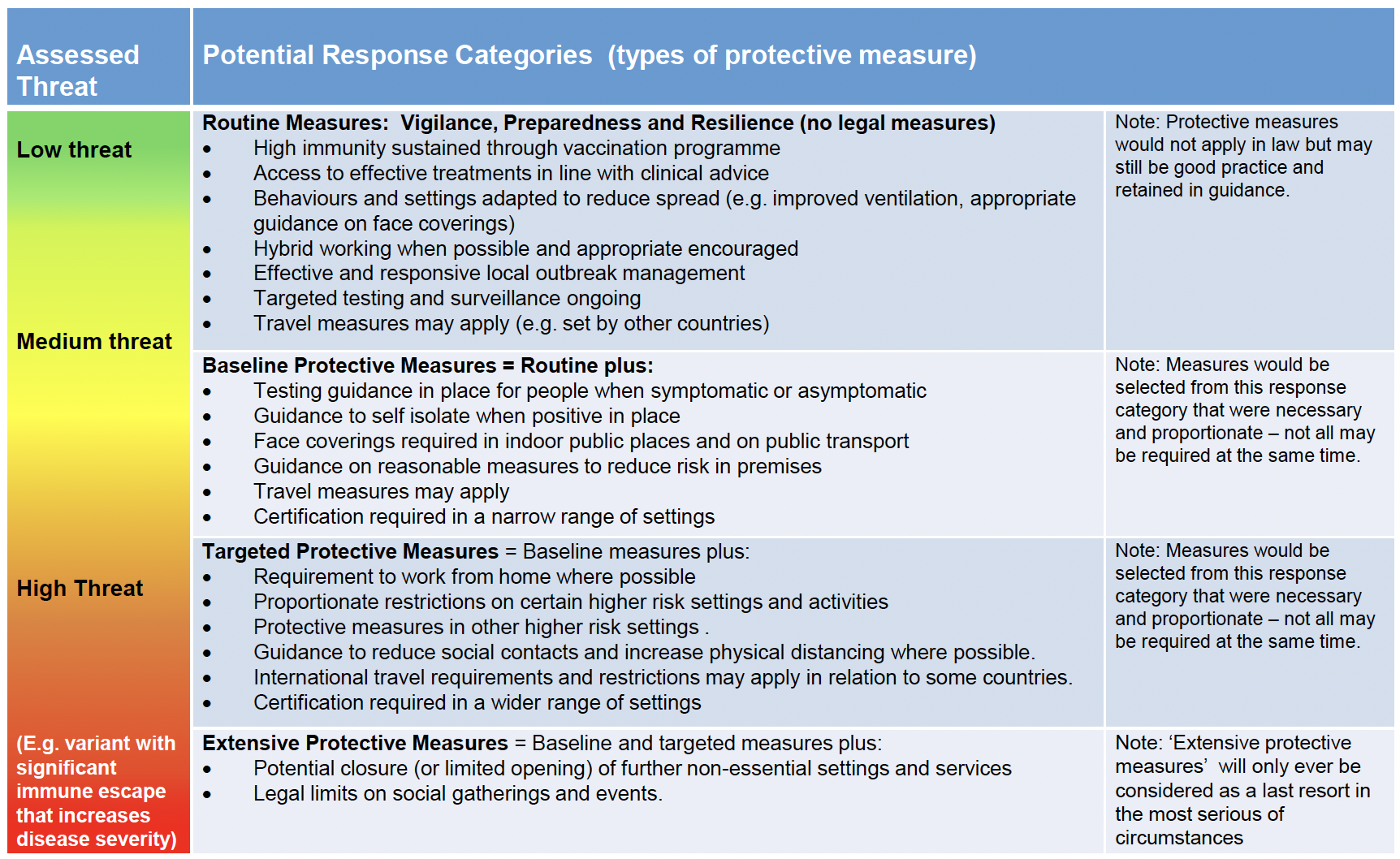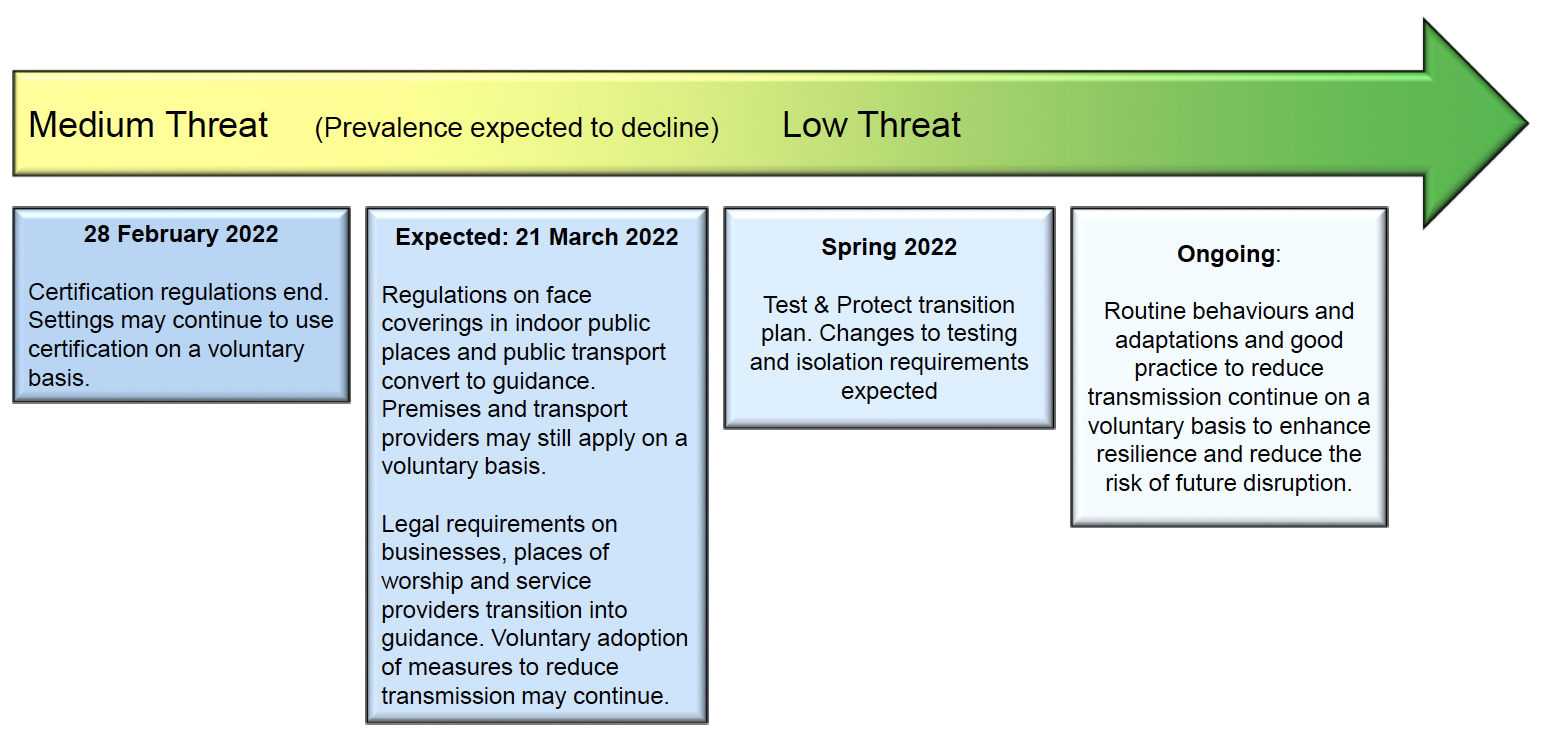Coronavirus (COVID-19): Scotland's Strategic Framework update - February 2022
This update of the Strategic Framework assesses where we are in the pandemic and sets out Scotland’s approach to managing COVID-19 and its associated harms effectively for the long term as we prepare for a calmer phase of the pandemic.
This document is part of a collection
Executive Summary
This update to our Strategic Framework takes stock of where we are in the pandemic and sets out our actions to respond to COVID-19 and its associated harms, and our approach to managing it effectively but also sustainably for as long as necessary.
As in countries across the world, the Omicron variant identified in November 2021 led to the highest rates of infection yet seen in Scotland, necessitating the deployment of temporary, targeted protective measures and support for sectors that were most affected. As that peak has subsided, though infection numbers are still high and pressures on the health and social care sector remain, we have been able to carefully but relatively quickly ease those measures.
We are now able to look forward to the rest of 2022 with increased optimism, albeit tempered by the need to remain prepared, vigilant and resilient given the ongoing uncertainties posed by this virus. While the recent high infection numbers led to some difficult challenges, our schools and most businesses remained open. And although the impacts on people, communities, businesses and other organisations have not been evenly felt – with some experiencing much greater hardships than others - our overall economic output has now recovered to its pre-pandemic level, and unemployment is close to record lows.
We hope that the epidemic will now move into a calmer phase, made possible by the remarkable progress on vaccination and in new treatments, which have both helped reduce the severity of the impact of the virus. COVID-19 remains a threat, but we are hopeful that this threat will continue to reduce as we head into the spring and summer.
In view of these positive developments, we are now updating our strategic intent from a focus on suppressing cases to managing COVID-19 effectively, primarily through adaptations and health measures that will strengthen our resilience and recovery. In the future, and as far as possible, we intend to rely much less on legal requirements and more on people and organisations making and sustaining the adaptations to behaviours and physical environments that will improve our resilience to the virus and help keep it in check.
For individuals and families this will include continued hygiene measures, improving ventilation, and wearing face coverings when and where appropriate (this may vary depending on levels of infection at different times). When we judge it is safe and prudent to do so, we will further relax guidance on self-isolation, and target testing for a narrower range of purposes – for example, to support ongoing surveillance, outbreak management, rapid response to new variants, and access to care and treatment for those most at risk. We intend to do this through a managed and phased transition.
For organisations, becoming more resilient to COVID-19 may include, for example, ensuring that sick pay and staffing practices are aligned with public health aims, adapting premises to make them safer for customers and staff, and enabling hybrid working where that makes sense and supports businesses and individuals.
This will not mean a return to conditions exactly as before the pandemic but it will help ensure that the impact of the virus on the trade and activities of businesses is much reduced.
We know, however, that while securing stability is crucial, the future path of the pandemic is uncertain and that the threat of new and potentially more harmful variants remains. We must therefore remain vigilant and ready to respond in a proportionate manner to any future threats, in order to mitigate the harm that they might otherwise cause.
The updated framework sets out our progress and the next steps we will take, working closely with partners, to deliver this approach. First and foremost, we will continue to consolidate and strengthen the vaccination programme. We will be informed by JCVI advice and draw on advances in vaccine technology – our objective is that everyone who will benefit from vaccination is able to receive it, and as regularly as recommended.
We will continue to deliver the necessary testing capability to enable ongoing surveillance – including genomic sequencing to allow the early identification of new variants, and effective public health responses – including self-isolation where appropriate, treatment and outbreak management. We will continue to gather, publish and analyse data – both nationally and internationally – to support our management of the epidemic.
We will seek to ensure that people have appropriate access to effective treatment for COVID-19, drawing on advances in technology and therapeutics. We will focus on improving mental health and wellbeing. And we will support those who are at higher clinical risk from COVID-19 and continue work to tackle health inequalities.
Given the ongoing uncertainty inherent in the pandemic, working with our partners, we will continue to develop and implement clear outbreak management plans, with appropriate supporting legislation and guidance, at institutional, local and national level so that people and organisations can understand what may be required and in what circumstances, and can respond accordingly.
We will be ready to respond to any increase in the threat posed by the virus, whether that comes from waning immunity, a new variant or other factors. We will apply careful judgement, taking all relevant factors into account, including the increased resilience that we expect to secure through adaptations and health measures.
We set out a clear framework of potential responses to assessed threats to provide as much clarity as possible for planning purposes, while retaining the necessary flexibility to ensure that responses are appropriately targeted. It is important to note that not all potential threats will be uniform in their impacts and our response must take account of all relevant factors. Our objective is to be targeted and proportionate.
The categorisation in Figure 1 below will guide future decisions. Deciding what 'threat' level should apply at any given time will involve both an assessment of data and the application of judgement. So too will determining what range of measures might be necessary in response (the measures outlined below are included for illustrative purposes - it will not necessarily be the case that all of them are applied at each 'threat' level). What we have already learned, not least from the experience of Omicron, is that not all risks - e.g. new variants - will have the same impacts, so we cannot have a one size fits all response. For example, a new variant that is highly transmissible but of lower severity may represent less of a threat than one that is less transmissible but more severe. That is why setting fixed thresholds or triggers for action – e.g. a set number of cases per 100,000 population - would not be appropriate or helpful, as it would potentially result in either under or over reaction. Judgement about the nature and likely impact of any future risks will be key.

We judge that our current situation – with a highly transmissible variant, resulting in a high level of infection, but with a lower severity of impact than previous variants - represents a medium threat. However, we consider that this will reduce in the coming weeks to a low threat, enabling us to lift the remaining legal measures in place. Should the threat level remain medium/low in the weeks ahead, it is therefore our intention to do so on the following timescale as set out in Figure 2:
- 28 February - COVID certification scheme will cease to be a legal requirement. The app will remain available to support any business wishing to implement a voluntary scheme.
- 21 March (indicative date, to be confirmed at preceding review) – the legal requirement to wear face coverings in public indoor places and on public transport will convert to guidance. Other remaining legal requirements will convert to guidance and good practice as appropriate.

As regulations are converted into guidance, we will ensure that clear information is in place to help people and organisations make and sustain the changes required to reduce transmission of the virus on a routine basis. This will involve maintaining and enhancing some of the behaviours and physical adaptations that have helped reduce transmission and will help to improve public health more generally going forwards.
More generally we will continue to work with sectors across the economy and broader society as we continue to mitigate the ongoing and accumulated harms of the crisis and, in parallel, as we collectively press forward with the recovery and transformation of our public services and rebuild for a better future. We know that COVID-19 has caused some in our society to experience greater harm, so we will seek to ensure that our actions do not exacerbate inequality, but improve outcomes instead. We outline here a range of activity that is helping to support our businesses, schools and other educational settings, social care, housing, transport, justice and other public services, consistent with our COVID-19 Recovery Strategy.
We know that sustainably reducing the harm from COVID-19 in Scotland also depends on what is happening with the pandemic internationally. We will apply proportionate travel measures – though only when necessary – and we will continue to work with partners in developing countries to enhance management of COVID-19 internationally and support the delivery of vaccines, treatment and surveillance.
We will continue to learn the lessons from COVID-19 to inform our thinking about possible future pandemics and other emergencies. We will co-operate fully with the public inquiries that are now underway in Scotland and the UK. And we will remember all those who have suffered and lost loved ones.
Though clear challenges remain on the road ahead, we are optimistic that with continued collective endeavour, and through vigilance, resilience and preparedness from people and organisations across Scotland, a prolonged calmer phase of the epidemic is in view, enabling us now to plan ahead with a greater sense of stability and confidence.
Contact
Email: CEU@gov.scot
There is a problem
Thanks for your feedback